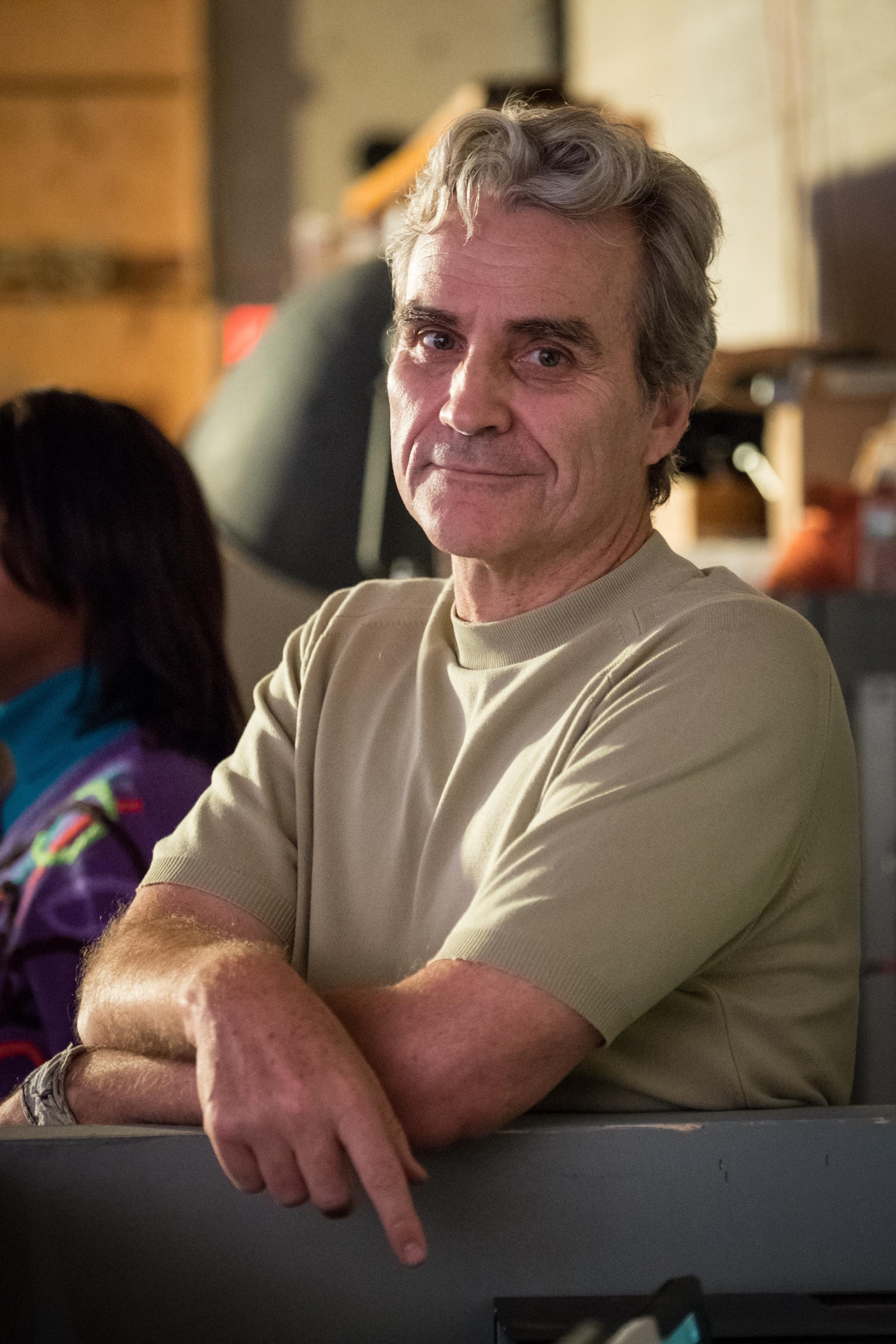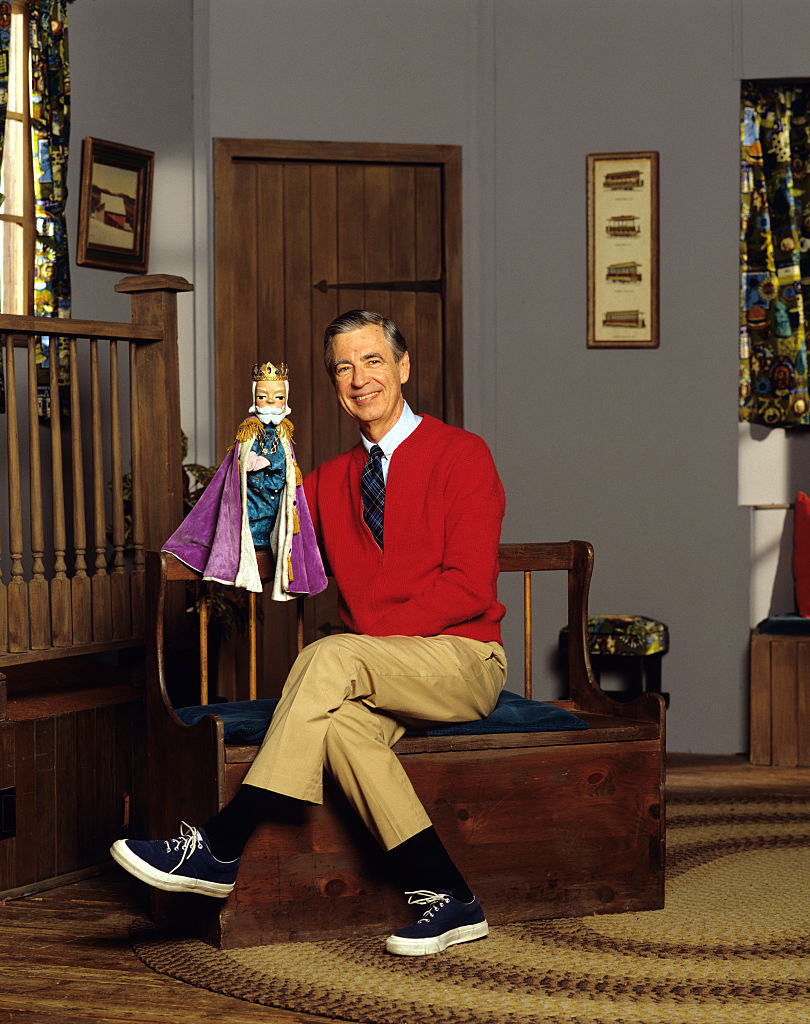The movie A Beautiful Day in the Neighborhood is structured like an episode of Mister Rogers’ Neighborhood. Fred Rogers, whose gentle nature Tom Hanks wears as comfortably as his red cardigan, begins by introducing the viewer to a story about his friend, journalist Lloyd Vogel (The Americans’ Matthew Rhys). Scene transitions show toy cities, just like those used on the legendary children’s show, only Lloyd’s story is unfolding in Manhattan, rather than Pittsburgh.
Though Hanks’ Mister Rogers is the storyteller in Marielle Heller‘s new film, the movie’s inspiration, a 1998 Esquire cover story, positions him instead as a subject. In the article, headlined Can You Say… Hero?, journalist Tom Junod—the basis for the fictionalized Lloyd—conveys Rogers’ astonishing goodness through a series of anecdotes: Rogers, a Presbyterian minister, prayed for people by name every day. He made connections everywhere he went—with a young fan with cerebral palsy, with the famed gorilla Koko (also an ardent fan). He helped a blind child who was struggling to pray, and he loved taking pictures of everyone he met to show to his wife, Joanne.
As Lloyd does in the movie, Junod became close with Rogers after the children’s TV host saw something special in him. The movie, in theaters nationwide on Friday, is not a play-by-play of either man’s life—for one thing, Junod never got into a fight with his father at his sister’s wedding, as Lloyd does—but Junod says that while Lloyd’s on-screen circumstances are fictionalized, the depiction of their friendship is as close to reality as he could have hoped.
“I expected to have some distance from it,” Junod tells TIME of his experience watching the film. “And, as it turned out, I had no distance at all. The way Matthew [Rhys] played it, I recognized myself in the character.”
Who should be TIME’s Person of the Year for 2019? Cast your vote in the reader poll.
This is the story of how Rogers, who died in 2003, changed Junod’s life forever.
‘I had no idea how to write about a person like Fred’

Before he was assigned to interview Rogers for an Esquire issue about American heroes, Junod had earned a bit of an unsavory reputation. In an October 1997 cover story titled “Kevin Spacey Has a Secret,” he coyly outed the actor, though Spacey refused at the time to confirm or deny any speculation about his sexuality. The story led to a tailspin of controversy and many in Hollywood refusing to cooperate with the magazine and the journalist himself.
“The thing that damaged me about the Kevin Spacey story was not that we revealed that Kevin was gay—it was that we revealed Kevin was gay for a purpose that was not worth the revelation,” Junod says. “We were looking to make a splash.” (Spacey came out as gay in 2017, after actor Anthony Rapp accused him of assaulting him when Rapp was 14, in 1986. Spacey responded on Twitter that he was “horrified” by the allegations but did not recall the encounter.)
It was at that juncture that an editor at Esquire thought giving Junod a chance to interview Rogers—widely considered the nicest guy in the world—could be the key to redeeming himself. Junod says he had “no idea how to write about a person like Fred” after a run of writing successful stories about darker subjects. (He earned a National Magazine Award for a 1995 story called “The Rapist Says He’s Sorry,” about a convicted sex offender undergoing therapy.)
So when he was first assigned this profile, Junod wasn’t sure how to proceed. Rogers’ team was hesitant, too.
As the movie depicts, Bill Isler (played by Enrico Colantoni), whom Junod refers to as Rogers’ “majordomo,” ran Rogers’ production company. Isler had read Junod’s work and didn’t think he was a good fit to do the interview. “[Isler] protected Fred, and he did not want Fred to do this story,” Junod says. But in the end, Rogers said he wanted to work with the journalist anyway.
“Why it was Fred who made that decision, he never told me,” Junod admits. “Fred moved in mysterious ways, he really did.”
While he still doesn’t know whether Rogers had read the Spacey article, Junod believes Rogers recognized that he was going through a moment of transformation after “losing trust” in himself. “That’s what Fred, I believe, saw, and sort of decided to work on in his own inimitable way,” he says.
‘Goodness is as mysterious and interesting to write about as badness’

Working with Mister Rogers wasn’t easy for Junod. And Rogers was’t shy about switching the roles of interviewer and interviewee, asking questions and trying to learn more about his new friend.
Still, the journalist didn’t know what to make of the TV host. “It was a complete mystery to me, how he could be who he was, how he could stay who he was,” Junod says, “that it wasn’t a pose, it wasn’t an act.”
That mystery ended up paving the way for a compelling story, as Junod sought to understand how Mister Rogers could be so good. As it turned out, he found that question just as thrilling as investigating what made other subjects bad.
“I think that that was a lesson that stood me in good stead for the rest of my time as a journalist,” says Junod.
As screenwriters Noah Harpster and Micah Fitzerman-Blue conducted research for a script, they discovered an archive of files that Rogers had kept on everyone and everything he loved.
Junod had a file. Among its contents was a list of four pillars of journalism that Rogers hoped his friend would stick to: that journalists are human beings; that they should point out injustice when necessary; point out beauty when it’s possible; and celebrate the wonders of creation.
The writer has no idea whether these were meant as pieces of advice, lessons or notes Rogers perhaps learned from Junod himself. But, he says, “I think Fred was interested in the [journalism] process as well.”
‘He practiced [kindness] like he practiced a musical instrument. I think he did the scales every day’

Junod wasn’t surprised to learn that his friend had kept meticulous notes on their correspondence. After all, Rogers woke up daily at 5 a.m. to pray and read and swim; he famously even ensured that he weight the same exact amount—143 pounds—without fluctuation. This was a deeply disciplined man.
But the notes also offered a peek into how Rogers was able to be so good, seemingly all the time. Junod says it was with tools like his notes—using discipline to be a good friend or a good partner—that he was able to uphold such goodness throughout his life.
For Junod, there’s always been a bit of a misconception about Rogers. He’s not like Superman—he isn’t otherworldly. He’s like Batman. “Batman didn’t have any superpowers. He made himself into a superhero with his utility belt and all his training,” Junod says. “Obviously he has a lesson to teach about kindness, but I think that he also has a lesson to teach about the attainment of kindness, that kindness is a practice.”
Junod continues, “He practiced it like he practiced a musical instrument. I think he did the scales every day.”
‘Tom plays Fred as a person to be reckoned with’

If Mister Rogers were alive today to see A Beautiful Day in the Neighborhood, Junod is pretty sure that he would enjoy the film. “I think he would have liked that Tom [Hanks] sort of straddles the line between following Fred’s gestures and mannerisms, but not doing an imitation of Fred,” he says. “I think Tom plays Fred as a person to be reckoned with, and I think Fred was a person to be reckoned with.”
Now a senior writer at ESPN, Junod is working on a 10,000-word story. (Which, in journalism these days, is quite long. This story is around 1,400 words.) It’s on a difficult topic, but Junod says that it has a resolution he really likes. When he saw the movie for the first time, in a screening room in New York City over the summer, he asked himself: What would Mister Rogers think of my work?
Upon realizing the answer, he stopped to appreciate how he had come to take Rogers’ lessons with him.
“I thought to myself that Fred would be proud of this—that Fred’s ideas about journalism were not in vain,” Junod says. “And I was really quite moved by it.”
More Must-Reads From TIME
- The 100 Most Influential People of 2024
- The Revolution of Yulia Navalnaya
- 6 Compliments That Land Every Time
- What's the Deal With the Bitcoin Halving?
- If You're Dating Right Now , You're Brave: Column
- The AI That Could Heal a Divided Internet
- Fallout Is a Brilliant Model for the Future of Video Game Adaptations
- Want Weekly Recs on What to Watch, Read, and More? Sign Up for Worth Your Time
Write to Rachel E. Greenspan at rachel.greenspan@time.com